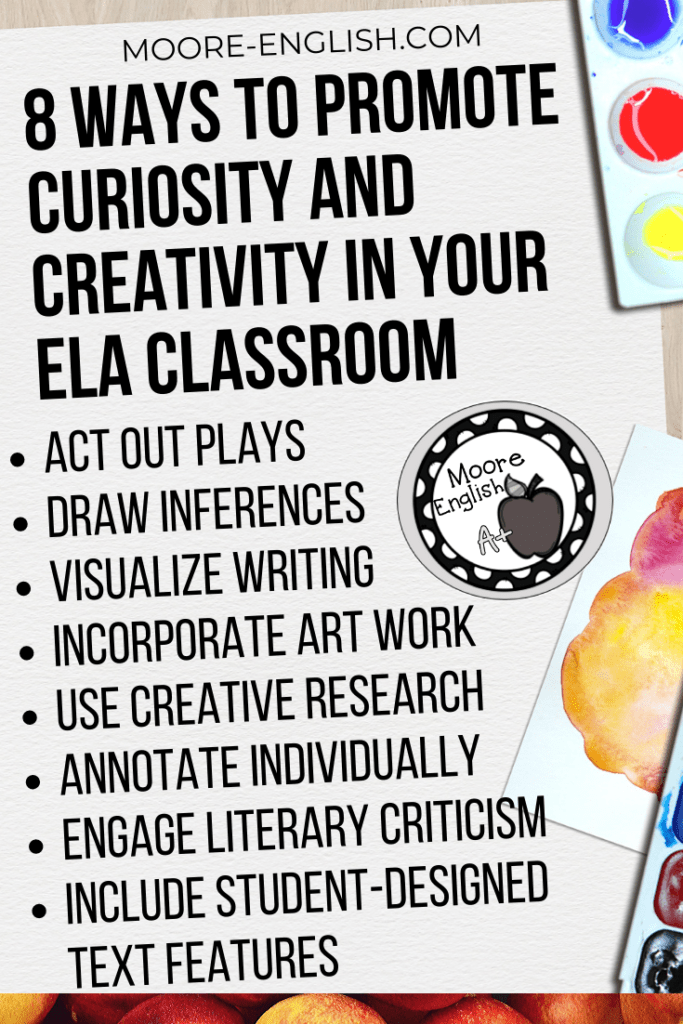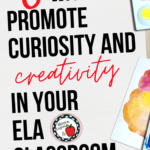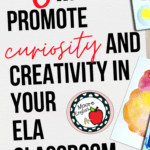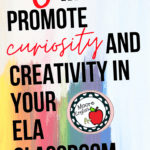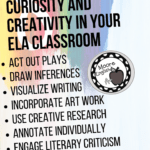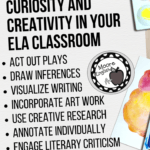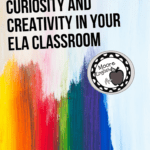A few months ago, I read this post from David Geurin’s blog. In his writing, he challenges teachers to ask this question: “How can I move the needle toward curiosity and creativity in learning? How can I leverage curiosity and creativity to help students master standards? How can students access this curriculum in ways that build curiosity and creativity too?”
After I read this question, I immediately started to think about my own classroom. Where do I promote curiosity and creativity? And where can I work to incorporate more curiosity and creativity?
In the months since I read David’s original post, I’ve been reflecting on this question. Therefore, I’ve put together a list of ideas for incorporating creativity and promoting curiosity in the ELA classroom.
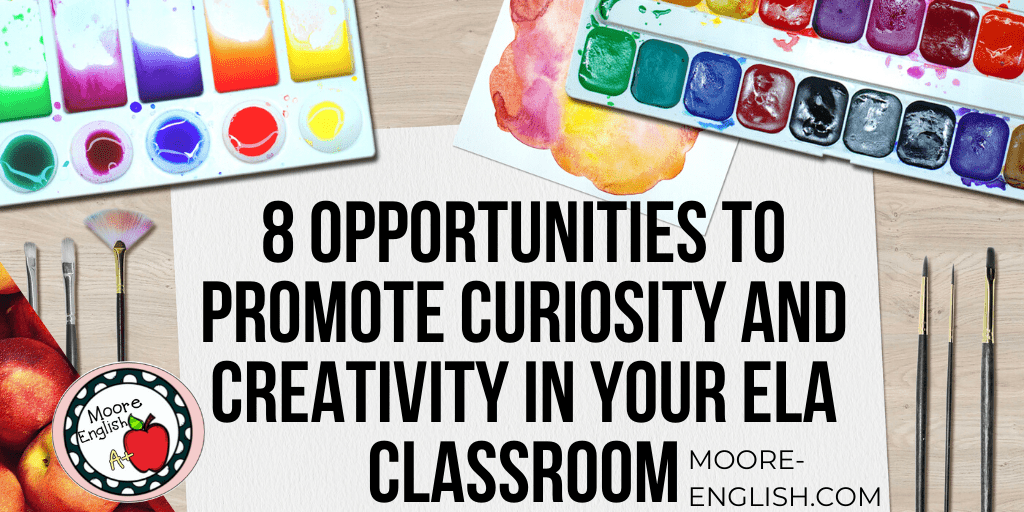
This post this post may contain affiliate links. Please read the Terms of Use.
Incorporating Curiosity and Creativity in Research
First, teaching research skills is such an important part of being an ELA teacher. At the secondary level, teachers and students dive into informative and argumentative writing. And producing these kinds of writing requires students to engage in research skills.
As ELA teachers, we can get focused on writing at the expense of research skills. But it’s important that teachers don’t take students’ research skills for granted. Furthermore, research provides ample opportunities for incorporating curiosity and creativity.
To begin, any time students engage in research, teachers have the opportunity to promote curiosity. To start, create writing prompts or opportunities that encourage students to explore topics and issues that are interesting or relevant to them. But this does not mean giving students free range to write about any topic that suits their fancy. However, if you write prompts that give students some room to explore, they will be more engaged and more curious!
Similarly, research requires creative thinking. In a world of Google searches, it’s easy to overlook the creative aspects of research. However, choosing search terms and putting together a collection of balanced research requires students to think outside the box. Additionally, incorporating alternative sources such as literary nonfiction, memoirs, and poetry can provide opportunities for creative thinking. And here are my favorite task cards to promote creativity in research.
Finally, challenging students to create their own text features is one of my favorite ways to marry the creative and the curious. Check out my favorite text features card sort.
Promoting Curiosity and Creativity in Literature
Teachers can also promote creativity and curiosity through teaching literature. Here are some of my favorite ways to bring creativity and curiosity to the study of literature.
Literary Criticism
First, incorporating literary criticism is a great way to promote curiosity and creativity. By its nature, literary criticism requires creative thinking because students have to take on new viewpoints. Similarly, literary criticism requires students to approach a text from a variety of lenses. And this kind of cognitive contortion can invite creative thinking. Add curiosity to literary criticism by encouraging students to explore esoteric critical lenses. Here are some tools for teaching literary criticism:
- Guided Notes for Introducing Literary Criticism: This tool encourages students to apply a variety of critical lenses to a single text. So this is a perfect tool for promoting creative thinking!
- Introducing Historical and Biographical Criticism: Promote curiosity by encouraging students to dig into a writer’s historical and biographical context.
- Literary Criticism Task Cards: This is a fun way to encourage students to think creatively.
- Teaching Literary Criticism with Taylor Swift is a fun way to introduce students to critical lenses through the texts of popular music!
Artwork
Another way to add creativity into literature instruction is to include artwork. Students can make connections to classic artwork. In particular, I like to use artwork with Shakespeare’s plays and with mythology. Here are some resources for incorporating artwork into your instruction:
- Visualizing Shakespeare: This resource collects questions and artwork for Shakespeare’s most famous works: Romeo and Juliet, Julius Caesar, Hamlet, Macbeth, and Taming of the Shrew.
- The Folger Shakespeare Library has a huge variety of online resources. In addition to using artwork to complement instruction, teachers can find primary sources, performances, and podcasts here, too.
- The Metropolitan Museum of Art in New York City has a digital collection teachers can browse for artwork to complement instruction. They even have a section dedicated to educators, which includes lesson plan ideas.
Visualizing Leads to Curious and Creative Thinking
At earlier stages in my career, I rejected the power of visualization. However, now I know that visualization improves retention. Now, I regularly incorporate visualization strategies into my teaching. Here are some opportunities to incorporate visualization to promote creative and curious thinking:
- First, brainstorming is a powerful way to encourage students to think creatively about writing. Brainstorming can also promote curious thinking by helping students determine what they want to know. Check out more ideas for visualizing writing.
- Similarly, annotation is a visualization strategy that leans heavily on creative thinking. Overall, annotation is deeply personal. As a result, annotation can be idiosyncratic and creative. Now, check out my favorite tools for annotating poetry and nonfiction.
- When teaching drama, encouraging students to act out the play can help students visualize the text. And taking on different characters also encourages students to think creatively about the play. Make the most of teaching drama with these strategies!
- Additionally, students can use visualization to practice making inferences. First, students can draw characters and settings based on inferences about a text. Then, students can color a text’s mood based on inferences. And these same visualization strategies also encourage students to question a text. In this way, interrogating the text promotes curious thinking. Finally, I’ve collected my 10 Favorite Poems for Teaching Inference.
When I think back to David’s original challenge, I think specifically about the small actions teachers can take. Curiosity and creativity both happen in small ways and in tiny moments. In the classroom, small moments can drown during all the crunch and chaos. However, one easy way to “move the needle” toward curious and creative thinking may simply be to let those moments breathe. Linger there. Invest in those moments. Let me know how it goes.


